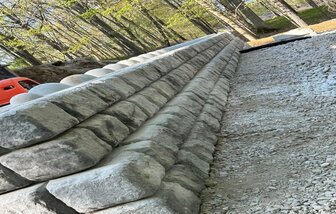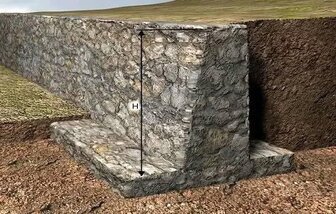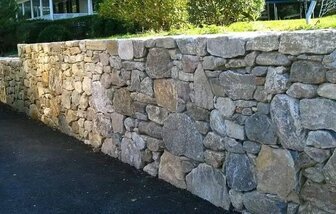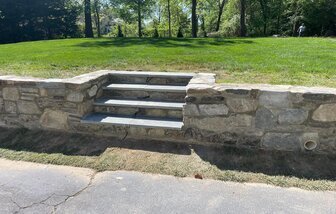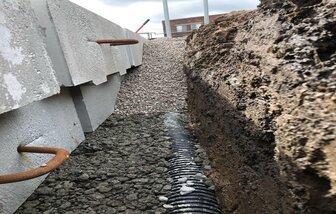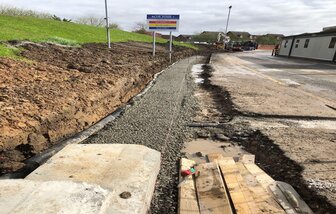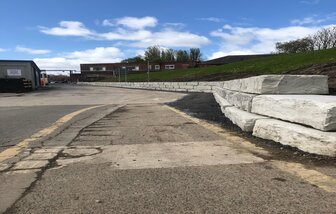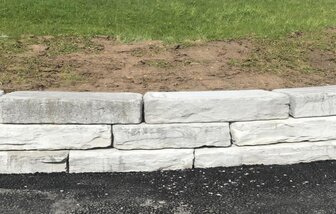How to Maintain Retaining Walls in the UK
Learn all about retaining walls, their importance in preventing soil erosion, and their applications in both residential and commercial settings in the UK. Discover the different types of retaining walls, how to inspect and maintain them, and the best practices for cleaning, drainage, waterproofing, and addressing structural damage. Get essential winter maintenance tips and know when to call a professional for complex repairs to ensure the stability and longevity of your retaining walls.
Introduction to Retaining Walls & Best Maintenance Practices
Retaining walls are essential structures designed to hold back soil and prevent erosion in various landscapes. They are a crucial component in both residential and commercial settings, ensuring that elevated terrains remain stable and safe.
In the context of the UK, retaining walls serve a variety of purposes, from supporting roadways and creating level terraces in gardens to preventing landslides in hilly areas.
Several types of retaining walls are commonly used throughout the UK. Gravity walls, for example, rely heavily on their mass to resist the pressure of the earth behind them.
These walls are typically constructed from heavy materials such as concrete, stone, or brick. Cantilever walls, on the other hand, use a reinforced concrete stem and base slab to convert horizontal pressure from the retained soil into vertical pressure on the foundation. This design is particularly effective for taller walls.
Sheet piling walls are another prevalent type, especially in areas with loose or soft soil. These walls consist of vertical sheets of steel, vinyl, or wood driven deep into the ground to provide stability.
Lastly, anchored walls use cables or rods anchored into the rock or soil behind the wall to provide additional support, making them suitable for high walls or those under significant pressure.
Proper maintenance of retaining walls is vital to ensure their longevity and structural integrity. Without regular upkeep, these walls can deteriorate, leading to potential safety hazards and costly repairs.
Maintenance activities might include inspecting for cracks or bulges, ensuring proper drainage to prevent water buildup, and repairing any damaged sections promptly.
By understanding the different types of retaining walls and the importance of their maintenance, property owners can ensure these structures continue to function effectively for many years.
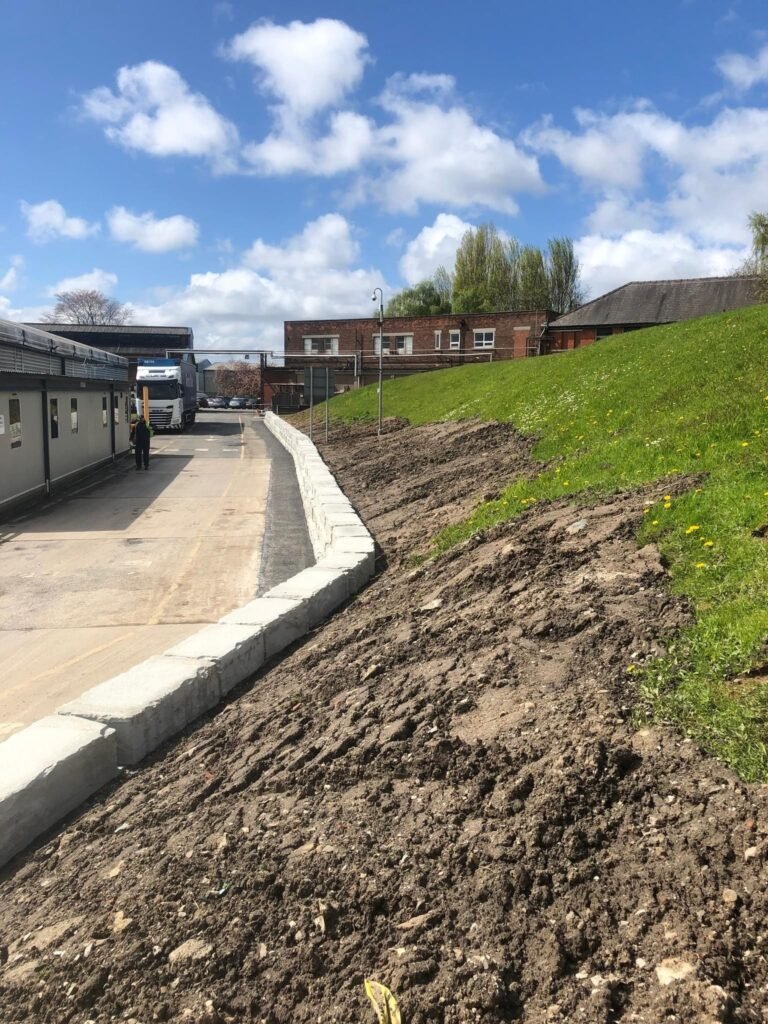
Maintaining the structural integrity of retaining walls in the UK necessitates regular inspections. These inspections are crucial for identifying potential issues early, which can prevent costly repairs and ensure the longevity of the wall. During an inspection, several key elements should be examined closely.
Firstly, cracks are a common sign of distress in retaining walls. These can appear in various forms, such as horizontal, vertical, or diagonal fissures. While minor cracks might be superficial, larger or expanding cracks can indicate significant structural problems that require immediate attention. It’s essential to monitor these cracks over time, noting any changes in size or pattern.
Bulging or leaning sections of a retaining wall are another red flag. Such deformations typically suggest that the wall is under excessive pressure or that its foundation is compromised. A bulge in the wall could be a precursor to a complete failure if not addressed promptly. Observing the wall from different angles can help detect any unusual curvature or displacement.
Water damage is another critical aspect to inspect. Water can infiltrate retaining walls through poor drainage or heavy rainfall, leading to erosion and weakening the structure. Look for signs of water staining, efflorescence (a white, powdery substance on the surface), and vegetation growth, which can indicate persistent moisture issues. Ensuring proper drainage around the wall can mitigate these problems significantly.
Erosion around the base of the retaining wall should not be overlooked. This can happen due to inadequate drainage or heavy rainwater runoff, which washes away the soil supporting the wall. Inspect the soil for signs of displacement or hollowing, particularly after heavy rainfall.
As for the frequency of inspections, it is recommended to conduct a thorough check at least once a year. However, walls that are older or have a history of issues may require more frequent inspections. While homeowners can perform basic inspections, consulting a professional is advisable for a comprehensive assessment. A professional can provide expert insights and recommend necessary repairs or reinforcements to maintain the wall’s stability and safety.
Maintaining the cleanliness of retaining walls is crucial to their longevity and structural integrity. Regular cleaning helps prevent the accumulation of debris and organic matter, which can retain moisture and promote the growth of mold and mildew. Begin by removing any leaves, twigs, and other debris from the surface of the wall. A stiff-bristled brush or a pressure washer can be useful tools for this task. However, be cautious with pressure washers as excessive force can damage the wall’s surface.
Vegetation management is another important aspect of maintaining retaining walls. Overgrown plants and roots can exert pressure on the wall, causing cracks and structural weaknesses. Regularly trim any vegetation near the wall, and consider planting low-maintenance ground cover plants that do not have invasive root systems. Applying a weed barrier and mulch can also help in keeping unwanted plants at bay.
Proper drainage is essential to prevent water buildup behind the retaining wall, which can lead to soil erosion and increased hydrostatic pressure. Inspect drainage systems, such as weep holes and drainage pipes, to ensure they are functioning correctly. Weep holes should be clear of blockages to allow water to escape from behind the wall. If weep holes are obstructed, use a thin rod or pipe cleaner to remove the blockage.
Drainage pipes, typically installed at the base of the retaining wall, should also be checked regularly. Make sure they are free from clogs and that water flows freely through them. If you notice any signs of water pooling or soil erosion near the wall, it may be an indication that the drainage system is not working effectively. In such cases, consulting a professional to assess and rectify the issue is advisable.
By keeping retaining walls clean and ensuring proper drainage, you can significantly extend their lifespan and maintain their structural integrity. Regular maintenance checks and prompt attention to any issues will help prevent costly repairs and ensure the wall continues to serve its purpose effectively.
Retaining walls are essential for preventing soil erosion and managing landscapes, particularly in the UK where varied weather conditions can impact structural integrity. One of the most common issues faced by retaining walls is the development of cracks. These cracks can vary in size and orientation, each indicating different underlying issues that need to be addressed promptly to maintain the wall’s stability.
Hairline cracks are small, thin cracks that appear on the surface of the wall. These are typically less than 1 millimetre wide and are often caused by minor shrinkage or natural settling. While hairline cracks generally do not indicate serious structural problems, they should be monitored. If they begin to widen, it may be a sign of more significant issues.
Vertical cracks, running up and down the wall, can be more concerning. They often indicate movement in the foundation or the wall itself. Causes can include soil shifting, water pressure, or inadequate drainage. Vertical cracks require careful examination, and it may be necessary to consult a structural engineer to determine the most appropriate repair methods.
Horizontal cracks are typically the most serious, as they often signify that the wall is bowing or bulging due to excessive pressure from the soil behind it. This type of crack usually demands immediate attention and professional intervention to prevent potential wall failure.
For minor damages, such as hairline cracks, a suitable repair material like masonry crack filler or epoxy can be used to seal the cracks and prevent further water infiltration. However, when dealing with vertical or horizontal cracks, or any signs of wall movement, it is crucial to seek professional assistance. A qualified contractor can assess the extent of the damage and recommend appropriate solutions, which may include reinforcing the wall with steel bars, rebuilding sections, or improving drainage behind the wall.
Regular inspection and maintenance are vital to preserving the integrity of retaining walls. By addressing cracks and structural damages promptly, homeowners can ensure their retaining walls remain stable and functional over the long term.
The integrity of retaining walls is heavily influenced by the surrounding soil and vegetation. Proper soil compaction is critical; it helps prevent soil erosion and slippage, which can compromise the stability of the wall. Compacted soil provides a solid foundation, reducing the pressure on the retaining wall and ensuring its longevity. To achieve optimal soil compaction, consider using techniques such as mechanical compaction or adding stabilizing agents.
Vegetation management is equally important in maintaining retaining walls. Tree roots, in particular, pose significant risks as they can grow and exert pressure on the wall, leading to cracks or even collapse. It is advisable to select plants with non-invasive root systems. Ground covers and small shrubs are generally safe choices, as they provide aesthetic value without causing structural damage.
For existing vegetation, regular maintenance is necessary to mitigate potential risks. Pruning tree roots and removing any invasive species can help protect the structural integrity of the retaining wall. Additionally, incorporating a root barrier system can serve as a preventive measure, ensuring that roots do not encroach upon the wall’s foundation.
In terms of plant selection, opting for native species is beneficial. Native plants are typically well-adapted to the local soil and climate conditions, requiring less maintenance while providing effective ground cover. This not only helps in preventing soil erosion but also promotes a balanced ecosystem. Furthermore, plants with deep root systems should be avoided near retaining walls, as they can destabilize the soil and exert undue pressure on the wall structure.
By focusing on proper soil compaction and thoughtful vegetation management, the durability and effectiveness of retaining walls can be significantly enhanced. These measures not only preserve the structural integrity but also contribute to the overall aesthetic and ecological balance of the area.
Waterproofing and sealing are essential practices in maintaining the structural integrity and longevity of retaining walls in the UK. Proper waterproofing prevents water from seeping into the wall, which can lead to erosion, cracks, and ultimately, failure of the wall structure. Different types of retaining walls, such as those made from concrete, stone, or timber, require specific waterproofing products and techniques to ensure their durability.
For concrete retaining walls, using a high-quality waterproofing membrane is crucial. These membranes can be either liquid-applied or sheet-applied and are designed to create a barrier against water infiltration. Liquid-applied membranes are particularly effective as they can seamlessly cover irregular surfaces and gaps. Epoxy coatings and polyurethane-based sealants are also popular choices for concrete walls, providing a robust layer of protection that can withstand harsh weather conditions.
Stone retaining walls, on the other hand, benefit from breathable sealants that allow moisture to escape while preventing water ingress. Silane or siloxane-based sealants are highly recommended for stone walls due to their ability to penetrate deeply into the material, offering long-lasting protection. For timber retaining walls, applying a waterproof wood preservative is essential. These preservatives not only protect against water damage but also guard against rot and insect infestation.
Regular inspection is vital to identify signs that a retaining wall needs re-sealing. Indicators such as visible water stains, mold growth, or efflorescence (a white, powdery substance on the surface) suggest that the waterproofing layer has deteriorated. In such cases, re-sealing should be performed promptly to prevent further damage.
To apply sealants correctly, ensure the wall surface is clean and dry. Remove any dirt, debris, or previous sealant layers, and repair any cracks or holes. Apply the sealant evenly using a brush, roller, or spray, ensuring full coverage of the wall. Allow sufficient drying time as recommended by the manufacturer before exposing the wall to moisture.
In conclusion, regular waterproofing and sealing are pivotal in maintaining the functionality and appearance of retaining walls. By selecting the appropriate products and techniques for your specific wall type and performing timely re-sealing, you can significantly extend the life of your retaining wall.
Winter weather in the UK presents unique challenges for maintaining retaining walls. Ensuring these structures are prepared for frost, snow, and ice is crucial in preventing damage and prolonging their lifespan. One of the primary concerns during the winter months is frost heave, a phenomenon where freezing and thawing cycles cause soil to expand and contract, potentially exerting pressure on the wall. To mitigate this, it’s essential to ensure proper insulation and drainage around the retaining wall. Installing frost-resistant materials can help reduce the impact of temperature fluctuations.
Another critical aspect of winter maintenance is managing snow and ice accumulation. Heavy snow can add significant weight to a retaining wall, increasing the risk of structural failure. Regularly clear snow from behind the wall to prevent undue stress. Additionally, avoid using de-icing salts near retaining walls, as these chemicals can accelerate the deterioration of the wall materials. Instead, opt for sand or non-corrosive de-icing products that are less likely to cause damage.
Ensuring drainage systems remain clear is also paramount during the winter months. Blocked drains can lead to water accumulation behind the wall, which may freeze and expand, resulting in cracks and other structural issues. Regularly inspect and clean drainage channels, particularly before and after major storms, to prevent water build-up.
Monitoring the condition of your retaining wall throughout the cold months is essential. Look for signs of movement, such as leaning or bulging, which could indicate underlying issues exacerbated by winter weather. Any visible cracks should be addressed promptly to prevent them from worsening. Additionally, check for signs of water damage or erosion at the base of the wall, as these could indicate drainage problems.
By taking these proactive steps, you can help ensure that your retaining walls remain sturdy and functional throughout the winter season, safeguarding your property and maintaining the integrity of these important structures.
While maintaining retaining walls can often be managed through regular inspections and minor repairs, there are certain scenarios where professional intervention is essential. Recognizing these situations early can prevent further damage and ensure the longevity of the structure.
One of the critical signs that professional help is needed is significant structural damage. If you notice large cracks, bulging, or leaning in your retaining wall, it is crucial to seek the expertise of a specialist. These symptoms often indicate underlying issues that are beyond the scope of standard DIY repairs and require a comprehensive assessment and tailored solutions.
Complex repairs also necessitate professional involvement. Tasks such as drainage system failures, foundation issues, or extensive erosion control are best handled by experts who have the experience and tools to address these intricate problems effectively. Attempting these repairs without the necessary knowledge can lead to further damage and increased costs in the long run.
Additionally, if initial DIY efforts fail to rectify the issues, it’s a clear indication to call a professional. Sometimes, even minor problems can be more complicated than they appear, and persisting with unsuccessful repairs can exacerbate the situation. A qualified contractor can provide a proper diagnosis and implement the correct measures to restore the integrity of your retaining wall.
When choosing a contractor, it is important to consider their qualifications, experience, and reputation. Look for professionals who specialize in retaining wall construction and maintenance, and check for reviews or testimonials from previous clients. A reputable contractor will conduct a thorough assessment, discuss the necessary repairs, and provide a detailed estimate of the costs involved.
During the professional assessment and repair process, you can expect a comprehensive evaluation of the retaining wall’s condition. The contractor will identify the root cause of the issues and propose a plan of action. This may include structural reinforcements, improved drainage solutions, or other specialized repairs tailored to the specific needs of your retaining wall.
In summary, knowing when to call a professional is crucial for maintaining the safety and functionality of your retaining wall. By recognizing the signs of significant damage, complex repairs, or unsuccessful DIY attempts, and by selecting a qualified contractor, you can ensure that your retaining wall remains a stable and reliable structure for years to come.
What is a Retaining Wall?
Discover the essential aspects of retaining walls in landscape architecture. This comprehensive guide covers the types of retaining walls, materials used, and key design considerations. Learn about the construction process, regulations, and maintenance tips to ensure stability and longevity.
Types of Retaining Walls
Discover the importance of retaining walls in the UK, used to stabilise sloped terrain, prevent soil erosion, and manage water runoff. Learn about different types including gravity, cantilever, sheet piling, anchored, gabion, and reinforced soil retaining walls, and understand their applications, materials, advantages.
What is the purpose of Retaining Walls?
Discover the importance of retaining walls in landscaping and structural engineering. Learn about different types of retaining walls such as gravity walls, cantilever walls, sheet piling walls, and anchored walls.
Garden Retaining wall
Discover the essential role garden retaining walls play in landscaping, from erosion control to aesthetic enhancement. Learn about the benefits, popular materials, and design ideas to transform sloped gardens into functional and beautiful outdoor spaces.
Building Retaining Walls
Learn about retaining walls and their essential role in landscape design, offering both functional and aesthetic benefits. Discover various types of retaining walls, suitable materials, and important planning and design considerations to ensure stability and sustainability.
Foundation Depths For Retaining Walls
Discover the importance of retaining walls in landscaping and structural engineering. Learn about different types of retaining walls such as gravity walls, cantilever walls, sheet piling walls, and anchored walls. Follow a step-by-step guide
How to maintain Retaining Walls
Learn all about retaining walls, their importance in preventing soil erosion, and their applications in both residential and commercial settings in the UK. Discover the different types of retaining walls, how to inspect and maintain them, and the best practices
Retaining Wall Building Materials
Learn about different types of retaining walls and their applications, including concrete blocks, poured concrete, natural stone, brick, timber, and gabion baskets. Understand their benefits, limitations, and how to choose the right material for your project to ensure both functionality and aesthetic appeal.
Ready to start your project?
Let's Work Together
To get started, for general enquiries simply complete the form below. Provide us with your project details, and our team will review your requirements. We will then get back to you with a customised solution that fits your needs. Whether you have a small-scale project or a large-scale development, we have the expertise and resources to handle it.
If you prefer, you can also send us your project documents and any photographs to Price@totalregen.co.uk for pricing. We will carefully review your documents and provide you with a competitive quote.

